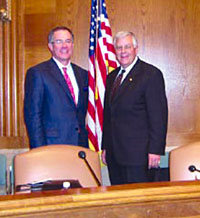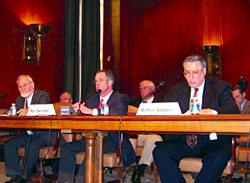OSHA and Small Business: Improving the Relationship for Workers
By Masonry
 For the most part, May 10, 2005, was like any other Tuesday. To say it was a slow, uneventful news day might be putting it mildly. However, this day was far from normal, as a quiet meeting was held at the U.S. Capitol that may revolutionize the masonry trade forever.
For the most part, May 10, 2005, was like any other Tuesday. To say it was a slow, uneventful news day might be putting it mildly. However, this day was far from normal, as a quiet meeting was held at the U.S. Capitol that may revolutionize the masonry trade forever.
On this day, Roy Swindal ? Owner of Masonry Arts, Inc., Mason Contractors Association of America (MCAA) Vice President for Region B, and MCAA State Chairman for Alabama ? testified before the Senate Subcommittee on Employment and Workplace Safety to encourage using a "Training Exchange Program" between mason contractors and Occupational Safety and Health Administration (OSHA) compliance officers.
"Some of our qualified Safety Directors would have the opportunity to walk through with OSHA compliance officers and others who write standards and guidelines and have the opportunity to demonstrate, on the job, what sort of problems they encounter with particular standards and how difficult it is for them to comply," explains Marian Marshall, MCAA's Director of Government Affairs and creator of the Training Exchange Program concept.
Although there are many benefits accompanying this proposal, the main rationale behind the Training Exchange Program is to lessen the number of erroneous citations being given to mason contractors.
Mason contractors and the MCAA have had to battle OSHA on several different issues over the years. Most recently, MCAA took on OSHA concerning having to remove materials from scaffolding at the end of the day, as well as explaining that grouting the wall was part of the construction process and how bracing both sides of the wall before completing this task would be almost impossible.
"I believe that many citations are issued as a result of a misunderstanding of the application of a standard or that OSHA compliance officers interpret the standard too literally," says Swindal. "The Training Exchange Program could help contractors avoid unnecessary citations and relieve them of the costs of hiring an attorney to fight the citation."
Marshall says that the citations were only one part of her reasoning behind creating the Training Exchange Program idea.
 "When I first met with the committee staff, those [scaffolding and grouting] citations weren't actually in the back of my mind," Marshall says. "What was in the back of my mind was coming up with some reasonable ways for industries to work more cooperatively and less confrontationally with OSHA."
"When I first met with the committee staff, those [scaffolding and grouting] citations weren't actually in the back of my mind," Marshall says. "What was in the back of my mind was coming up with some reasonable ways for industries to work more cooperatively and less confrontationally with OSHA."
Swindal agrees, "The Training Exchange Program could prove to be an invaluable tool to all masonry construction contractors and other specialty trades because we would have an opportunity to interact more directly with OSHA compliance officers and ensure that they have a better understanding of our businesses in a voluntary and non-confrontational fashion."
The Program has been well received by OSHA representatives and the committee members. If all goes well, Marshall hopes that MCAA and OSHA will be able to implement the Training Exchange Program in the next few months, starting with a two-year pilot of the program to demonstrate its effectiveness.
"I hope that we will be able to work with them and perhaps, if possible, implement the program without legislation ? I'm all for that," says Marshall.
The following witness statement was made by Roy Swindal, MCAA member and Owner of Masonry Arts, Inc., before the Subcommittee on Employment and Workplace Safety, of the U.S. Senate Committee on Health, Education, Labor and Pensions on Tuesday, May 10, 2005:
Chairman Isakson, members of the Subcommittee, thank you for the opportunity to testify before you today on small-employer concerns with rules and regulations promulgated and enforced by the Occupational Safety and Health Administration (OSHA).I own a mason contracting business in Bessemer, Ala. I do a variety of masonry work throughout the country.
As I'm sure most of you are aware, OSHA has a variety of programs in place to exchange ideas with trade associations about "best practices," which their member companies have in place to protect employees on the job and improve upon the effectiveness of standards impacting their industries.
The Mason Contractors Association of America has an Alliance with OSHA, which focuses on scaffolding, fall protection, wall bracing and forklift safety issues. Our Director of Engineering, with the help of several others in industry, has written a handbook on wall bracing, which OSHA actually refers to for guidance on wall bracing issues. These alliances are, in our view, invaluable because they allow us to share ideas with OSHA on how we can better protect the health and safety of our workers. I commend OSHA for the resources they dedicate to this important effort.
The Mason Contractors Association would like to expand on this concept through our existing Alliance ? in essence take it one step further ? and allow qualified safety personnel from our industry to train OSHA compliance officers and agency personnel responsible for writing, interpreting and enforcing health and safety standards, primarily those impacting construction and masonry.
We have had some initial conversations with OSHA about this, and they seem very willing to work with us to establish what we like to call a "Training Exchange Program." We have also asked the agency to add a masonry-specific course to its curriculum at the OSHA Training Institute and, again, have someone with broad experience from our industry assist in teaching OSHA officials about the practical applications of some of the standards they write and enforce such as scaffolding, fall protection, the overhand bricklaying exemption and other issues specific to our specialty trade.
By way of example, two years ago contractors in Florida and Massachusetts were cited for leaving materials on the scaffolding at the end of the work shift. The materials are left there for a number of reasons.
First and foremost, it would be impossible to remove part of a pallet of bricks from the scaffolding without creating some very precarious and life-threatening problems. Moreover, many of these materials remain so the masons can simply pick up where they left off the previous day.
OSHA's strict interpretation of this standard would have forced contractors to bring laborers on the job site an hour prior to the start of a shift and pay them overtime to remove the materials at the end of the shift. This simply made no sense, and we met with the Directorate of Construction at OSHA to explain to them that they were actually creating more safety problems. OSHA ultimately issued a different interpretation to allow contractors to leave materials on the scaffolding without being cited. But it is this type of situation [that] could easily be avoided if we as contractors were allowed to offer very detailed training and guidance to agency officials, most of whom have very little hands-on construction experience.
While it may be the case that only the larger mason contractors would have the resources to make this Training Exchange Program work, every mason contracting company, small and large, would ultimately benefit. Our goal here is information sharing and the resolution of interpretations and/or citations in a non-confrontational fashion. The number one goal of any contractor is the health and safety of their workforce. If our industry is allowed to work more cooperatively with OSHA to help avoid the issuance of certain citations due to a lack of understanding about a particular provisions application, we will do a great service to the industry, the OSHA officials and the Administrative Law Judges who are already overwhelmed with work. It simply makes sense to have this type of collaborative structure in place.
The contractors and their employees will feel less threatened if they know OSHA has more knowledge and insight into the specifics of their trade. And the OSHA officials should be grateful for the knowledge they gain about an industry that contributes a tremendous amount of jobs and economic stability to our country.
Again, thank you for the opportunity to present these ideas to you today. I'd be happy to answer any questions.
For more information on the Training Exchange Program, please contact Marian Marshall at mjmarshall@masoncontractors.org or call (703) 671-4468.
About the Author
Masonry, the official publication of the Mason Contractors Association of America, covers every aspect of the mason contractor profession - equipment and techniques, building codes and standards, business planning, promoting your business, legal issues and more. Read or subscribe to Masonry magazine at www.masonrymagazine.com.


















